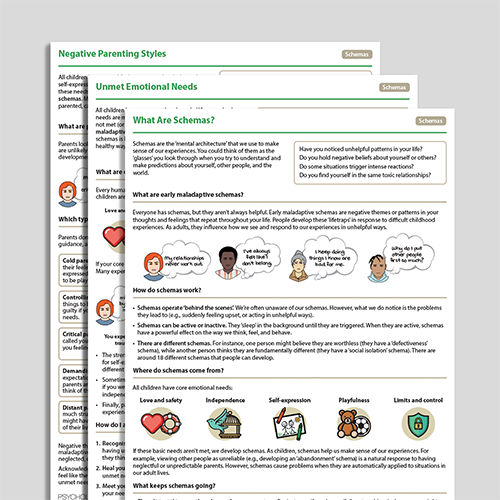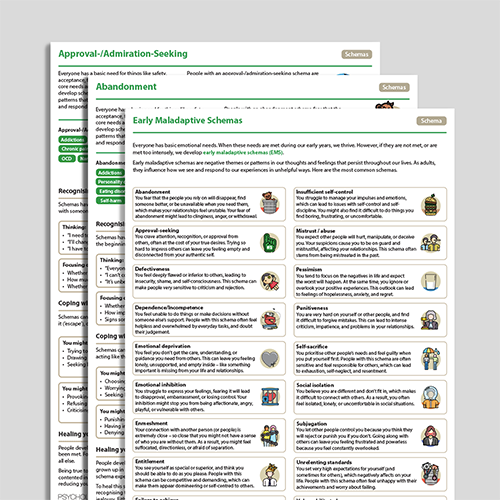New Series: Schemas

What’s new?
We’ve released a comprehensive series of information handouts, which explain core concepts in schema therapy and provide an overview of each schema described by Jeffrey Young and colleagues (2003).
What is schema therapy?
Schema therapy is an evidence-based, integrative therapy developed for treating complex and longstanding difficulties. It is based on the idea that psychological and relational problems often stem from early maladaptive schemas (EMS) and how individuals cope with them. As a therapy, it integrates elements of several approaches (including cognitive behavioral, attachment, gestalt, psychoanalytic therapies) into a unifying conceptual model. Schema therapy expands on CBT by exploring the developmental origins of psychological problems and addressing the maladaptive ‘coping styles’ that perpetuate them.
Schema therapy concepts can be challenging for clients to grasp. Our schema series is designed to make schema therapy more accessible for clients, and help you work more effectively with early maladaptive schemas (EMS). It’s available to all members with active subscriptions, whether you have a Basic, Advanced, or Complete plan.

Key concepts within schema therapy
This collection of handouts breaks down the key ideas in schema therapy and presents them in a straightforward and easily digestible manner. This allows clients to gain a better understanding of the approach and how it can help them. These resources include:
- What Are Schemas?
- Unmet Emotional Needs
- Coping Styles And Responses (Schema Therapy)
- Negative Parenting Styles

Early maladaptive schemas
The series also offers collated definitions of the schemas described by Young and colleagues (2003) and detailed handouts for each one, so clients can understand how they apply to them. These resources are designed to help clients recognize how specific schemas manifest in their lives, where they come from, and how they might cope with them. The handouts also outline what healing each schema might involve. These resources include:
- Early Maladaptive Schemas
- Abandonment
- Approval-/Admiration-Seeking
- Defectiveness
- Dependence/Incompetence
- Emotional Deprivation
- Emotional Inhibition
- Enmeshment
- Entitlement
- Failure To Achieve
- Insufficient Self-Control
- Mistrust/Abuse
- Pessimism
- Punitiveness
- Self-Sacrifice
- Social Isolation
- Subjugation
- Unrelenting Standards
- Vulnerability To Harm
Who is this series for?
Studies indicate schemas play a role in many psychological difficulties and can influence how individuals respond to therapy (Thimm & Chang, 2022; Haaland et al., 2011). As such, these resources will be useful for many clients and their therapists.
With client-friendly explanations, relatable examples, and engaging illustrations that bring schema concepts to life, these handouts will help your clients understand and relate to the schemas that impact their lives. This series also serves as an excellent learning tool for anyone interested in gaining a deeper understanding of schema therapy.
How can it be used?
These resources can help clients:
- Learn about the schema therapy model.
- Identify schemas that are relevant to them.
- Make links between their schemas and their current difficulties.
- Understand unhelpful patterns of behavior linked to their schemas.
- Explore where their schemas come from.
- Develop ideas about what healing their schemas might involve.
- Deepen their understanding of overlapping concepts in other therapies (e.g., core beliefs in CBT).
Therapists will also find them useful for:
- Assessing clients’ schemas.
- Introducing important concepts like unmet needs and coping styles.
- Developing formulations.
- Planning treatment.
Schema therapy is considered an effective way of conceptualizing and treating personality disorders. Rafaeli, Bernstein, and Young (2011) and Jacob and Arntz (2013) describe some of the uses of schema therapy:
- To place more emphasis than traditional CBT upon the development of current symptoms.
- To emphasize the therapist-patient relationship and its potential for corrective influence.
- To help patients understand their core emotional needs and to learn ways of meeting those needs adaptively.
- To focus on the processing of memories of aversive childhood experiences, making use of experiential techniques to change negative emotions related to such memories.
References
- Haaland, A. T., Vogel, P. A., Launes, G., Haaland, V. Ø., Hansen, B., Solem, S., & Himle, J. A. (2011). The role of early maladaptive schemas in predicting exposure and response prevention outcome for obsessive-compulsive disorder. Behaviour Research and Therapy, 49, 781-788. DOI: 10.1016/j.brat.2011.08.007.
- Jacob, G. A., & Arntz, A. (2013). Schema therapy for personality disorders—A review. International Journal of Cognitive Therapy, 6(2), 171–185.
- Rafaeli, E., Berstein, D. P., & Young, J. E. (2011). Schema therapy: Distinctive features. Routledge.
- Thimm, J. C., & Chang, M. (2022). Early maladaptive schemas and mental disorders in adulthood: A systematic review and meta-analysis. International Journal of Cognitive Therapy, 1-43. DOI: 10.1007/s41811-022-00149-7.
- Young, J. E., Klosko, J. S., & Weishaar, M. E. (2003). Schema therapy: A practitioner’s guide. Guilford Press.

